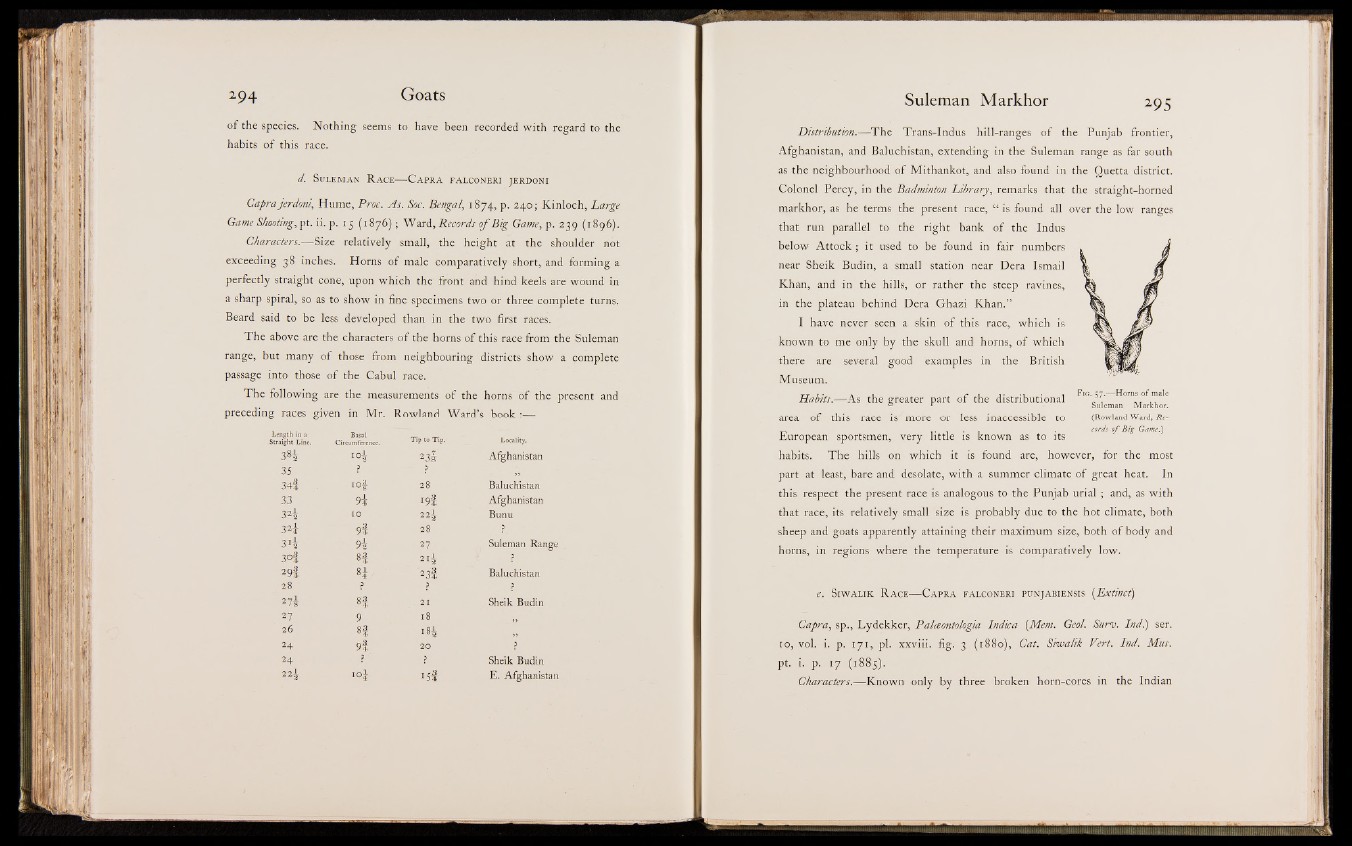
of the species. Nothing seems to have been recorded with regard to the
habits of this race.
d. Sul em an R a ce— C a p r a falconeri je rdo n i
Capra jerdoni, Hume, Proc. As. Soc. Bengal, 1874, p. 240:; Kinloch, Large
Game Shooting, pt. ii. p. 15 (1876); Ward, Records o f Big Game, p. 239 (1896);
Characters.— Size relatively small, the height at the shoulder not
exceeding 38 inches. Horns of male comparatively short, and forming a
perfectly straight cone, upon which the front and hind keels are wound in
a sharp spiral, so as to show in fine specimens two or three complete turns*
Beard said to be less developed than in the two first races.
The above are the characters o f the horns of this race from the Suleman
range, but many of those from neighbouring districts show a complete
passage into those of the Cabul race.
The following are the measurements of the horns- of the present and
preceding races given in Mr. Rowland Ward's book :—
Length in a
Straight Line.
Basal
Circumference. Tip to Tip. Locality.
3«i I02 23®'-' . Afghanistan
35 ? - ? „
34f iof 28 Baluchistan
33 9i i9l Afghanistan
32i IO 22I Bunu
324 9! 28 ?
# 4 9h ' 27 Suleman Rangt
3° i 1 2Ii • ?
29f n ' 23l Baluchistan
. 28 ' p ? ?
" 2" i 3Î 21 Sheik Budin
27 9 l8 n
26 m i8 i „
24 9î 20 ; ?
24 ? '■ '■/ Sheik Budin
22i I ° | ! 5f E. Afghanistar
Distribution.— The Trans-Indus hill-ranges of the Punjab frontier,
Afghanistan, and Baluchistan, extending in the Suleman range as far south
as the neighbourhood of Mithankot, and also found in the Quetta district.
Colonel Percy, in the Badmintqp Library, remarks that the straight-horned
markhor, as he terms the present race, “ is glund all over the low ranges
that run parallel tô . the right, bank of the Indus
below Attock ; it used to beKound in fair numbers
near Sheik Budin, a small station near Dera Ismail
Khan, and in the hillsjjlor rather the steep ravines,
in the plateau behind Dera Ghazi Khan.”
I have never seen a skin of this race, which is
known to melphlj by the skull and horns, of which
there are lèverai good examples in the British
Museum.
Habit^ ^ A s the greater part of the distributional
F ig. 57.— Horns of male
Suleman Markhor.
(Rowland Ward, Records
area of this race is7 more or le fl inaccessible to
19o f B ig Game.)
European Sportsmen, very little is known » to its
habits. The hills on which it is Bund are, however, for the most
part at least, bare and desolate, with a summer climate of great heat. In
this respect the present race is analogous’ to the Punjab urial ; and, as with
that race, its relatively small size is probably due to the hot climate, both
sheep and goats »parently attaining their maximum size, both of body and
horns, in regions where the temperature is comparatively low.
,j . Siw a l ik R ack— C a p r a falconeri punjabiensis (Extinct)
Capra, sp., Lydekker, Palaontologia Indica {Mem. Geol. Surv. Ind.) ser.
io, vol. i. p. 17 1 , pi. xxviii. fig. 3 (1880), Cat, Siwalik Vert. Ind. Mus.
pt. i. p. 17 (1885).
Characters.^—Known only by three broken horn-cores in the Indian